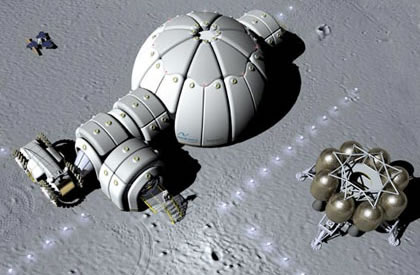Now that the United States is officially getting back into space exploration, the Moon now seems to be the focus - or at least the starting point - of a lot of plans involving space travel. The Trump administration has redirected NASA's priorities to settling on our lunar neighbor before Mars.
SpaceX CEO Elon Musk has said the BFR project will be a key factor in creating a
lunar base. To continue the trend, Bigelow Aerospace and the United
Launch Alliance (ULA) announced last week they would be collaborating to design
an inflatable habitat. The habitat would be launched into space by the end of
2022, and eventually function as a lunar depot.
Bigelow Aerospace is designing two B330 expandable modules, while ULA is
providing the Vulcan 562 configuration rocket that will carry the module into
low Earth orbit. A single B330 is roughly one-third the volume of the
International Space Station.
After the Vulcan rocket brings the B330 into low Earth
orbit, it will inflate, and Bigelow will outfit it with additional equipment and
put it through a series of tests.
Once it's fully up and running good, additional launches
will be carried out to provide 35 tons of cryogenic propellant to the module.
It will then be maneuvered into its final location: the low lunar orbit.
"We are excited to work with ULA on this lunar depot
project," said Bigelow Aerospace president Robert Bigelow in a statement.
"Our lunar depot plan is a strong complement to other plans intended to
eventually put people on Mars.
It will provide NASA and America with an exciting and
financially practical success opportunity that can be accomplished in the short
term. This lunar depot could be deployed easily by 2022 to support the nation's
re-energised plans for returning to the Moon."
The United States isn't the only country that has plans
for the Moon though. Russia and China are set to sign a multi-year space exploration deal that covers lunar
and deep space exploration, and Russia is working with NASA on the Deep Space Gateway project to
build a lunar space station.
Earlier this year, the China National Space
Administration (CNSA) and the European Space Agency (ESA) expressed a
desire to work together on an international lunar base, or a
"moon village," by 2020.
"The Chinese have a
very ambitious moon program already in place," said Pal A. Hvistendahl,
ESA's head of media relations, at the time.
"Space has changed
since the space race of the '60s. We recognise that to explore space for
peaceful purposes, we do [need] international cooperation."
It's been quite some time
since humanity saw the Moon as a worthwhile place to venture to. Regardless of
who manages to do it first, it's an exciting time for space travel.
Via Futurism


